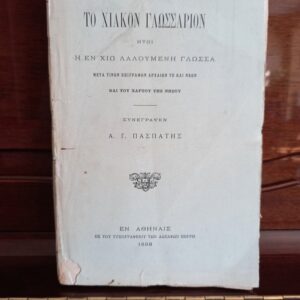1866, Central Committee Society, Drainage Lake Copais, Boeotia, Greece
100.00€
Only Copy for Sale Online!
Description
Η προς καταρτισμόν Ελληνικής Εταιρίας
δια την αποξήρανσιν της Κωπαιδας Λίμνης
συστηθείσα Κεντρική εν Αθήναις Επιτροπή
The Central Committee Organisation in Athens
to establish a Greek Society
for the drainage up of Copais Lake, including the Statutes
Published as a Leaflet of 16 Pages in Athens in 23rd of January 1866
by the Central Committee:
A. Georgantas, Ε. Tompatzis, A. Petsalis etc.
The drainage of Lake Copais (in the centre of Boeotia, Greece) has always been an issue of great importance for the inhabitants of the surrounding area, as if this was accomplished about 25.000 ha of fertile land would be available for cultivation. The Modern Greek Nation achieved to complete this project in 1931, after more than 100 years of efforts. The first documented successful attempt to drain Lake Copais is attributed to the Minyans (the Mycenaean inhabitants of Orchomenos) during the 2nd millennium BC. The Minyans led the main rivers that flooded Copais (Boeotian Kephisos and Melanas) to the natural sinkholes of the northeast edge of the basin, building large levees and strong retaining walls with a total length of about 20 km. The water was sunk into the sinkholes (underground crevices and tunnels in limestone) and reappeared at the North Euboean Gulf. These works had an instant impact on Copais, converting it to a large plain whose cultivation made the Minyans one of the wealthiest ancient civilizations. Although the impressive ancient drainage system of Copais has been extensively studied by archaeologists and engineers (such as Knauss, Kambanis, Kenney etc) many questions still remain unanswered regarding the way it worked.
Additional information
| Languages | Greek |
|---|
You may also like…
-

1888, The Glossary of the Island of Chios, To Chiakon Glossarion, First Edition, A.G. Paspatis
120.00€ Read more -

1857, Objection of King Otto of Greece to National Assembly, Rare Document
120.00€ Add to cart -

1877, A Letter to Ioannes Gennadius by Louis Drucker, Greece Economic Crisis
150.00€ Add to cart -

1863, PROCLAMATION KING GEORGE I OF GREECE To National Assembly
200.00€ Add to cart









